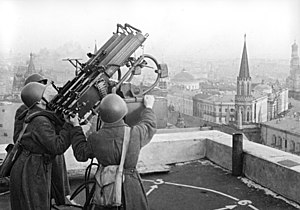Battle for Moscow
| Battle of Moscow | |||||||
|---|---|---|---|---|---|---|---|
| Part of the Eastern Front of World War II | |||||||
 Soviet anti-aircraft gunners on the roof of the Moskva hotel. |
|||||||
|
|||||||
| Belligerents | |||||||
|
|
|
||||||
| Commanders and leaders | |||||||
|
Adolf Hitler Fedor von Bock Heinz Guderian Albert Kesselring |
Joseph Stalin Georgy Zhukov Aleksandr Vasilevsky |
||||||
| Units involved | |||||||
| Strength | |||||||
|
As of 1 October 1941: 1,183,693–1,929,406 men, 1,000 tanks, 14,000 guns, Initial aircraft: 549 serviceable At time of counter offensive: 599 |
As of 1 October 1941: 1,250,000–1,400,000 men, 3,232 tanks, 7,600 guns, Initial aircraft: 936 (545 serviceable) At time of counter offensive: 1,376 |
||||||
| Casualties and losses | |||||||
| 174,000–400,000(see §7) | 650,000–700,000(see §7) | ||||||
Decisive Soviet victory
The Battle of Moscow (Russian: Битва за Москву, translit. Bitva za Moskvu) is the name given by Soviet historians to two periods of strategically significant fighting on a 600 km (370 mi) sector of the Eastern Front during World War II. It took place between October 1941 and January 1942. The Soviet defensive effort frustrated Hitler's attack on Moscow, capital of the Union of Soviet Socialist Republics (USSR) and the largest Soviet city. Moscow was one of the primary military and political objectives for Axis forces in their invasion of the Soviet Union.
The German strategic offensive, named Operation Typhoon (German: Unternehmen Taifun), called for two pincer offensives, one to the north of Moscow against the Kalinin Front by the 3rd and 4th Panzer Armies, simultaneously severing the Moscow–Leningrad railway, and another to the south of Moscow Oblast against the Western Front south of Tula, by the 2nd Panzer Army, while the 4th Army advanced directly towards Moscow from the west.
...
Wikipedia
